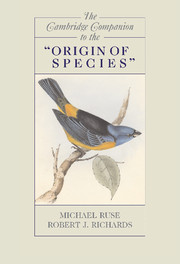Book contents
- Frontmatter
- Foreword
- Introduction
- 1 The Origin of the Origin
- 2 Darwin’s Analogy between Artificial and Natural Selection in the Origin of Species
- 3 Variation and Inheritance
- 4 Darwin’s Theory of Natural Selection and Its Moral Purpose
- 5 Originating Species: Darwin on the Species Problem
- 6 Darwin’s Keystone: The Principle of Divergence
- 7 Darwin’s Difficulties
- 8 Darwin’s Geology and Perspective on the Fossil Record
- 9 Geographical Distribution in the Origin of Species
- 10 Classification in Darwin’s Origin
- 11 Embryology and Morphology
- 12 Darwin’s Botany in the Origin of Species
- 13 The Rhetoric of the Origin of Species
- 14 “Laws impressed on matter by the Creator”? The Origin and the Question of Religion
- 15 Lineal Descendants: The Origin’s Literary Progeny
- 16 The Origin and Political Thought: From Liberalism to Marxism
- 17 The Origin and Philosophy
- 18 The Origin of Species as a Book
- Bibliography
- Index
6 - Darwin’s Keystone: The Principle of Divergence
Published online by Cambridge University Press: 28 January 2009
- Frontmatter
- Foreword
- Introduction
- 1 The Origin of the Origin
- 2 Darwin’s Analogy between Artificial and Natural Selection in the Origin of Species
- 3 Variation and Inheritance
- 4 Darwin’s Theory of Natural Selection and Its Moral Purpose
- 5 Originating Species: Darwin on the Species Problem
- 6 Darwin’s Keystone: The Principle of Divergence
- 7 Darwin’s Difficulties
- 8 Darwin’s Geology and Perspective on the Fossil Record
- 9 Geographical Distribution in the Origin of Species
- 10 Classification in Darwin’s Origin
- 11 Embryology and Morphology
- 12 Darwin’s Botany in the Origin of Species
- 13 The Rhetoric of the Origin of Species
- 14 “Laws impressed on matter by the Creator”? The Origin and the Question of Religion
- 15 Lineal Descendants: The Origin’s Literary Progeny
- 16 The Origin and Political Thought: From Liberalism to Marxism
- 17 The Origin and Philosophy
- 18 The Origin of Species as a Book
- Bibliography
- Index
Summary
Darwin chose an apt architectural image when he wrote J. D. Hooker that 'the “principle of Divergence” …with “Natural Selection” is the key-stone of my Book' (Correspondence 7: 102). In the Origin, the fifteen-page section on divergence is placed strategically at the end of Chapter 4 on natural selection, where it distributes the weight between the core theory and the evidence for descent. Darwin portrays adaptation and the origin of species as emerging out of the entangled plenitude of mutual relations mediated by natural selection. The principle of divergence united this ecological vision with Darwin’s complementary view that evolutionary history can be read in the irregular branching of the taxonomic tree of life. However, there is an irony in the historical fate of the principle. Much of twentieth-century evolutionary biology rejected Darwin’s explanation of 'speciation' as muddled (Mayr 1942, 1992; Sulloway 1979; Coyne and Orr 2004). Yet the profound depth of ecological relationships and the very diversity of life that Darwin evoked through the principle can be understood as one of the Origin’s most enduring contributions. Moreover, the standing of contemporary approaches to speciation that, like Darwin's, emphasize ecological factors - but now often supplemented by moderate isolation of various kinds - while remaining controversial, is perhaps higher than it has ever been.
- Type
- Chapter
- Information
- The Cambridge Companion to the 'Origin of Species' , pp. 87 - 108Publisher: Cambridge University PressPrint publication year: 2008
- 9
- Cited by



